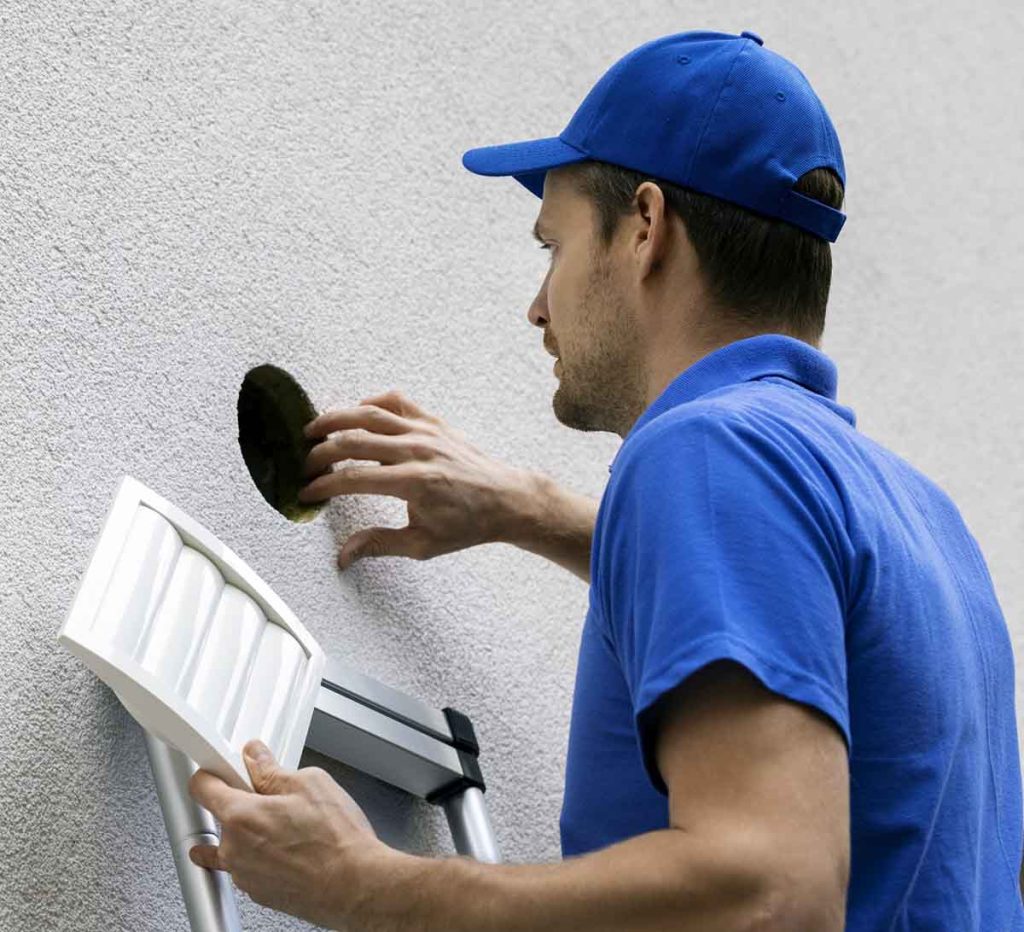Outside Exhaust Vent Cleaning
Gateway Cleaning Services provides outside exhaust vent cleaning for commercial buildings to ensure the proper functioning of ventilation systems.
Vents leading to the outside of a building are necessary for the kitchen, bathroom, dryer, and industrial exhaust systems. Over time, these external vents become clogged with grease, dirt, lint, dust, pollen, and other airborne particles. Dirty exterior vents can lead to reduced airflow, decreased ventilation efficiency, and potential issues with indoor air quality.
If the external vents are not regularly cleaned and maintained, the accumulation of dirt and debris will naturally increase over time. Routine cleaning and maintenance help prevent excessive buildup and keep the vents functioning optimally.
It’s important to note that the specific types of vents requiring cleaning may vary depending on the nature of the commercial establishment and its ventilation system. Gateway Cleaning Services can help identify the specific vents that need attention and develop a comprehensive cleaning plan tailored to the building’s requirements.

Commercial External Exhaust Vent Cleaning Services
Commercial external exhaust vent cleaning services are professional services that clean the exhaust vents in commercial buildings. These vents are a crucial part of the ventilation system and expel indoor air and pollutants to the outside. Over time, dust, dirt, and other contaminants can accumulate in these vents, which can affect indoor air quality and pose a risk to the building and its occupants.
Our services typically include the following:
- Inspection: The process usually begins with inspecting the external exhaust vents to assess their condition and determine the extent of cleaning required.
- Cleaning: Using specialized tools and equipment, the professionals clean the vents thoroughly. This could involve removing dust, grease, and other debris that have built up over time.
- Sanitizing: Depending on the service, sanitization of the vent system may also be done. This step kills bacteria and other harmful microbes that could pose health risks.
- Maintenance: Some services may also provide regular maintenance, which involves checking the vents periodically and cleaning them as needed.
- Reporting: After the service, a comprehensive report is usually provided. This includes details of the service performed, any issues discovered during the inspection and cleaning, and recommendations for future maintenance or repairs.
Types of Exhaust Vents
Several types of exhaust systems with external vents are common in commercial and industrial settings. These systems expel air, fumes, or contaminants from a specific area or process. Examples of exhaust systems with external vents:
- Kitchen Exhaust Systems: Commercial kitchens in restaurants, hotels, and other food establishments have dedicated exhaust systems. These systems consist of hoods above cooking appliances, ductwork that carries the exhaust air, and external vents that are expelled outside the building. Kitchen exhaust systems remove heat, smoke, grease, and cooking odors, ensuring a clean and safe environment.
- Bathroom Exhaust Systems: Commercial buildings, such as offices, malls, or hotels, typically have bathroom exhaust systems. These systems remove moisture, odors, and potentially harmful bacteria from the bathrooms. External vents located on the buildings exterior expel the stale air, ensuring proper ventilation and a fresh indoor environment.
- Industrial Ventilation Systems: Manufacturing plants, factories, and industrial facilities employ various types of ventilation systems to remove dust, fumes, or pollutants generated by industrial processes. These systems utilize external vents to exhaust the air contaminants and maintain a safe working environment. Examples include dust collection, welding exhaust, and chemical fume extraction systems.
- Dryer Ventilation Systems: Dryer ventilation systems are essential in commercial laundry facilities or multifamily properties with shared laundry rooms. These systems consist of dryers connected to ductwork that leads to external vents. The vents expel hot air, moisture, and lint generated during the drying process, preventing lint accumulation and reducing the risk of dryer fires.
These are just a few examples of exhaust systems with external vents. The exhaust system and vent configuration type can vary depending on the industry, building requirements, and local regulations.
Reasons Why External Vents Get Dirty
External vents can accumulate dirt and debris over time due to various factors. Here are 7 common reasons why exterior vents can get dirty:
- Dust and Airborne Particles: Outdoor air carries dust, pollen, and other airborne particles. These particles can settle on external vents, especially if the vents are located near dusty areas or in regions with high levels of airborne contaminants.
- Environmental Factors: External vents are exposed to the elements, including rain, wind, and storms. Over time, rainwater can carry dirt, leaves, and other debris onto the vents. Wind can blow debris such as leaves, branches, or dust onto the vents.
- Surrounding Vegetation: If there are trees, shrubs, or plants near the vents, leaves, twigs, seeds, and other plant materials can get lodged in the vents. This is especially true during fall when trees shed their leaves.
- Insects and Animals: External vents can attract insects, birds, rodents, and other small animals seeking shelter or nesting spots. They may bring in nesting materials, leaves, twigs, or other debris that can accumulate in the vents.
- Building Construction and Renovation: During construction or renovation activities, dust, construction debris, and building materials can enter the ventilation system through external vents if proper precautions are not taken. This can lead to a buildup of dirt and debris.
- Nearby Roadways or Industrial Areas: If the building is located near busy roadways, construction sites, or industrial areas, there may be increased levels of dust, pollution, or industrial emissions in the air. These pollutants can settle on external vents, contributing to their dirtiness.
- Lack of Regular Maintenance: If the external vents are not regularly cleaned and maintained, the accumulation of dirt and debris will naturally increase over time. Routine cleaning and maintenance help prevent excessive buildup and keep the vents functioning optimally.
It’s important to note that dirty external vents can lead to reduced airflow, decreased ventilation efficiency, and potential issues with indoor air quality. Regular cleaning and inspection of external vents are recommended to maintain their cleanliness and ensure the proper functioning of ventilation systems.
Contact Gateway Cleaning Services Today
Gateway Cleaning Services provides outside exhaust vent cleaning for commercial buildings to ensure the proper functioning of ventilation systems. Contact us today to request a free estimate and schedule an appointment.

